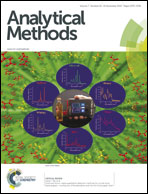Characterisation of antibody conjugated particles and their influence on diagnostic assay response†
Abstract
The batch-to-batch assay performance ‘activity’ of antibody conjugated particles is often variable, leading to poor reproducibility between different production batches. We therefore sought to quantify the properties of such particles using differential centrifugal sedimentation (DCS) to see how they influence assay performance, with the aim to improve the reproducibility of the conjugation reaction. The DCS high resolution size distributions of the antibody conjugated particles allowed us to examine the thickness of the antibody corona on the particles and to quantify the amount of ‘contaminating’ particle oligomers produced via carbodiimide chemistry. The DCS data was correlated with the assay response of the resulting conjugate using an interleukin 6 (IL6) lateral flow assay developed in house. We prepared a series of antibody conjugates using various carbodiimide reaction conditions and analysed the size, antibody corona and oligomerisation profile of the resulting particles using both dynamic light scattering (DLS) and DCS. Both the amount of antibody bound to the particle and the presence of higher order particle oligomers produced conjugates that when applied in an IL6 lateral flow assay were associated with an enhanced fluorescent signal. Both the amount of particle oligomers and antibody bound to the particle was found to be positively correlated with increased assay response in the lateral flow. The DCS estimation of protein corona thickness for each carbodiimide condition tested was found to correlate with the amount of antibody coupled to the particles, as assessed using the bicinchoninic acid (BCA) assay. We have shown the novel application of DCS for the analysis of antibody-particle conjugates. DCS analysis provides a quantitative method to characterise particles and provides a rationale for variable assay performance observed from batch-to-batch production.


 Please wait while we load your content...
Please wait while we load your content...